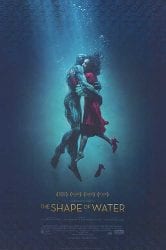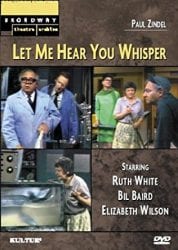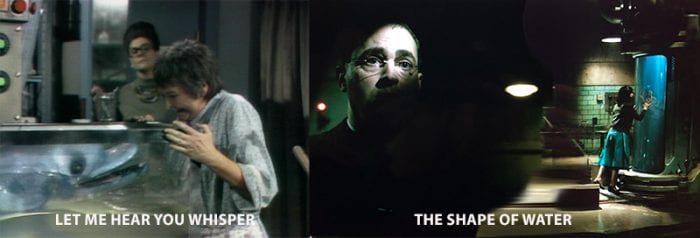The Shape of Water’s Ongoing Plagiarism Battle
New scandals prompt a fresh look at The Shape of Water...
 Two weeks ago, we took a look at the plagiarism controversy over The Shape of Water, the new film written and directed by Guillermo del Toro.
Two weeks ago, we took a look at the plagiarism controversy over The Shape of Water, the new film written and directed by Guillermo del Toro.
At the time, the controversy focused on similarities between The Shape of Water and The Space Between Us, a 2015 short film by students at the Netherlands Film Academy.
But, while the similarities were striking, there was no shortage of evidence that del Toro had been working on The Shape of Water as early as 2011, well before The Space Between Us was released.
With so much evidence that The Shape of Water could not have plagiarized the short film, the conversation shifted to exactly why the arguments felt so convincing. In short, the story became a useful example to discuss why some things in filmmaking felt like plagiarism when we knew for certain they could not be.
Unfortunately, that’s not where the story stopped. Since writing and publishing that post, two other plagiarism allegations have been filed against the film, at least one of which may shine new light on the original story.
The Shape of Water vs. Let Me Hear You Whisper
 Two days after my original post, the estate of playwright Paul Zindel publicly accused del Toro of plagiarizing Zindel’s 1969 play, Let Me Hear You Whisper.
Two days after my original post, the estate of playwright Paul Zindel publicly accused del Toro of plagiarizing Zindel’s 1969 play, Let Me Hear You Whisper.
The two works do have a great deal of overlap. Both stories are set in the sixties and feature a female custodian who befriends and eventually falls in love with a creature held captive in the military laboratory where she works. In both stories she frees the creature (using a laundry cart) in order to save it from vivisection after the creature fails to cooperate with its captors.
While that’s a lot of overlap, there are several key differences too. For one, in Whisper the creature is a dolphin and in Water it’s a humanoid creature. Also, the endings of the two works are drastically different.
Though others had noticed the similarities before January 25th, it wasn’t until Zindel’s son came forward that it began getting significant attention.

Fox Searchlight has denied that del Toro read Let Me Hear You Whisper, but there is evidence that Daniel Kraus, who pitched the story idea to del Toro in 2011, was not just aware of Zindel’s work, but an admirer.
This makes it almost certain that Kraus was aware of Let Me Hear You Whisper, even if del Toro was not.
Still, this does not necessarily prove plagiarism, but it does alter the previous story to be a possible case of common sourcing rather than a mere coincidence.
However, it wouldn’t be the only plagiarism allegation hurled at the film.
The Shape of Water vs. Delicatessen
 Earlier this week, French director Jean-Pierre Jeunet accused del Toro of plagiarizing a scene in The Shape of Water from his 1991 film Delicatessen.
Earlier this week, French director Jean-Pierre Jeunet accused del Toro of plagiarizing a scene in The Shape of Water from his 1991 film Delicatessen.
Both scenes feature two characters, one male and one female, sitting side by side and creating an impromptu rhythm to the beat of a musical playing on TV. In Delicatessen, the two use squeaks and creaks in a bed they are seated on to make the music while, in The Shape of Water, the two are seated on a sofa using their shoes to tap out the rhythm.
You can view the two clips here:
According to Jenuet, he confronted del Toro about this and he said that they both were taking inspiration from director Terry Gilliam.
However, this is a very different plagiarism allegation than the first one. It doesn’t look at the entire plot of the film and, instead, focuses on less than a minute of both works.
But, while both scenes feature characters making an impromptu rhythm to a musical on the TV, that’s roughly all they have in common. How they make the rhythm, where they’re sitting and the beat they make are all very different.
Even if it can be proved del Toro took the idea from Jeunet, it’s difficult to sustain an allegation of plagiarism. The scenes are so short and so different that both feel original. The similarities between The Shape of Water and The Space Between Us are far more striking (even setting aside the possible common source issue) and we know it’s impossible for Shape to have plagiarized it.
Still, as weaker as these allegations are, it’s more fuel for the plagiarism fire that’s burning around The Shape of Water as it heads into Oscar season.
Few Answers to Be Found
While we can dismiss Jeunet’s allegations, the ones made by the Zindel estate are much more difficult to overlook.
The similarities are very striking and we know that Kraus was a fan of Zindel’s work well before developing The Shape of Water. It seems very unlikely he was unaware of Let Me Hear You Whisper, especially since the play was adapted to television twice, once in 1969 and once in 1990.
Still, as noted by Sabine Jacques in The Conversation, a copyright infringement case by the estate against del Toro would have some significant challenges. Not only is it unclear if the similarities between the two works are copyrightable or that they are strikingly similar to one another to be considered a derivative work, but del Toro heavily documented the creation of the film and may be able to show it was an independent creation.
Unfortunately, we don’t have all of that evidence so there’s no way to determine what really happened with any certainty. We also don’t know if the students behind The Space Between Us were inspired by Let Me Hear You Whisper, possibility explaining the similarities between it and The Shape of Water.
But since we can’t know these answers definitively, we have to look at probabilities. Here, the probabilities are much higher than in the previous story. That’s not just because of the similarities, which get very detailed in places (the use of a laundry cart, mention of vivisection, etc.), but because of Kraus’ confirmed awareness and admiration of Zindel’s writing.
For his part, del Toro has held fast that his inspiration for the film was The Creature from the Black Lagoon, a 1954 film about a humanoid amphibious creature that falls in love with a woman. But while his creature definitely takes more cues from that film, the plot definitely mirrors Let Me Hear You Whisper more.
This puts all eyes on Kraus. Not only is he working on the novelization of the film but he claims to have come up with the original idea for the story, which he presented to del Toro in 2011. According to Kraus, the two worked on their projects together initially but separated out as time went on, agreeing that the novel and the movie would be different retellings of the story.
This makes it tough to say how much of the similarities are due to Kraus. But, since the similarities deal almost entirely with story and not style or dialogue, it seems likely that a great deal of it is Kraus’ work.
It’s not an answer to the plagiarism question but, frustratingly, it may be the best answer we’re able to get until new details come forward.
Bottom Line
There’s a terrible and overtly false expression about plagiarism that reads, “To steal from one person is plagiarism; to steal from many is research.”
As obviously untrue as that is (plagiarism deals with citation and not the number of sources) it has a kernel of wisdom when it comes to fiction.
Every trope we have started out as an original idea at some point, even if it was thousands of years ago. However, as other creators used it, built upon it and modified it, it went from being an original idea to being a basic building block of storytelling. However, the transition from original work to trope is not a smooth or clear one. In fact, it’s one that’s different for nearly every person interpreting it.
Did The Shape of Water plagiarize Let Me Hear You Whisper? Are the similarities coincidence? Were they both just building off of the same tropes? The answers to those questions aren’t clear in large part because the divide between a “yes” and a “no” isn’t very clear for any of them and the answers often say more about the person answering than the works in question.
As we discussed last time, with film we don’t neat plagiarism reports that showcase copied text. Outside of copied dialogue or cases like Shia LaBeouf’s where the plagiarism is nearly shot-for-shot, we don’t get a lot of clear answers when discussing plagiarism in film.
Still, with this case, there’s simply too much similarity to ignore and, given Kraus’ history with Zindel’s work, there is likely more to this story than pure coincidence or tropes.
However, we may never get confirmation of that, especially if this dispute never makes it to a trial.
Want to Reuse or Republish this Content?
If you want to feature this article in your site, classroom or elsewhere, just let us know! We usually grant permission within 24 hours.
